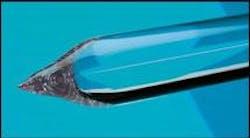Specialty fiber aids in component optimization
By MEGHAN FULLER
Several companies, including Corning, IntelCore Technologies, Nufern, AFL Telecommunications, Schott, and INO, announced new specialty fiber or enhancements to existing fiber during the Optical Fiber Communications (OFC) Conference in March. Despite a drastic decline in purchase orders for optical components, the specialty fiber market remains surprisingly active. According to industry analyst ElectroniCast (San Mateo, CA), the market is expected to jump from $382 million this year to more than $4 billion by 2010.
High-volume transmission fiber is used to transmit light over long distances with minimal change to the signal. Specialty fiber, by contrast, is used to manipulate the signal.
A critical building block of optical components and modules, specialty fiber directs, modifies, or strengthens an optical signal as it travels through a device. It is not used for transport.
Specialty fiber adds functionality to both active and passive components, including transmitters, modulators, receivers, multiplexers and demultiplexers, couplers, splitters, amplifiers, switches, add/drop modules, connectors, gratings, and attenuators. While these components and modules are not exactly flying off the shelves these days, the specialty fiber market nevertheless continues to be solid as component manufacturers are looking to specialty fiber as a way to optimize their products."In this particular market climate, more and more competitors are going after a lower level of business," explains Bill Beck, president and CEO at IntelCore Technologies (Boston). "That being the case, the situation very often ends up for customers that if they do not have the top-performing component, they don't get the business. What we will do is help component suppliers redesign existing components or introduce new components that have improved performance."
IntelCore does not market a specific line of specialty fiber, per se. Rather, the company has positioned itself as an OEM supplier, working with its customers on a nondisclosure basis to develop fiber optimized to their specific needs. The customer is very active in the design process.
"Even if there is not a lot of volume there, [our customers] want to be innovative," agrees Siska Boddez, product-line manager for high-index and reduced cladding fibers at Corning. "We currently see trends not in volume, but people working on their yields. Everyone is looking at cost-saving measures."
Specialty fiber types
Within the context of the total market, says Beck, specialty fiber can be defined as everything but transmission fiber. It can be optimized for different wavelengths, power levels, environments, temperatures, and radiation. Specialty fiber can range in price from a few dollars to nearly $1,000 per meter, depending on the materials and manufacturing process involved. That said, several types of fiber are currently more widely used, including erbium-doped fiber (EDF), polarization-maintaining fiber (PMF), photosensitive fiber, and high-index fiber.
EDF is used primarily as a gain medium for erbium-doped fiber amplifiers (EDFAs). This market should see increased interest among amplifier manufacturers that have begun to explore the possibility of using EDFAs in the metro and access segments. At OFC, Schott (Mainz, Germany) introduced an EDF based on compact oxide glass. The fiber will provide up to 50% more bandwidth than conventional erbium fiber, said Schott representatives at the show, while requiring spans of only 15 cm for C-band applications.
PMF maintains the polarization of light signals during propagation and keeps cross-coupling between the polarization modes at a minimum. There are four common markets for PMF, explains Carl Crossland, product-line manager for Corning's (Corning, NY) new PureMode products. It is used in lithium niobate modulators for signal modulation and Raman amplifiers for polarization multiplexing. PMF is also being used in pump pigtails and will see increasing use in polarization-mode dispersion compensation as systems migrate to 40-Gbit/sec speeds.
Photosensitive fiber is used primarily in fiber Bragg gratings, says Bill Tamm, director of applications engineering at Nufern (East Granby, CT). The company, which uses germanium and germanium boron co-doped fibers for enhanced photosensitivity, unveiled four lines
of photosensitive fibers at OFC, including cladding mode offset fibers, cladding mode suppressed fibers, pump locker fibers, and fibers mode-matched to SMF-28. The company also offers custom-made photosensitive fibers as well.
At OFC, Corning announced improvements to its line of high-index fibers, used in fused couplers, short-wavelength laser and LED sources, sensors, and DWDM components. The fiber now features improved geometry-better specifications on cladding diameter, mode field diameter, and core-clad concentricity, which will result in higher yields for coupler and pigtail manufacturers and lower splice loss for EDFA makers.
Corning is also working on a new line of reduced cladding fibers in response to the market trend toward miniaturization. "Normally, our fibers are 125-micron cladding," says Boddez. "Reduced cladding is only 80 microns. People want to make smaller components, smaller form-factor applications and amplifiers. That's why they are interested in fiber that they can bend smaller to fit into smaller packages."
Other specialty fiber types include holey or crystal fibers, recently unveiled by the likes of INO (Quebec City) and Crystal Fibre A/S (Birkeroed, Denmark.). INO also recently announced its ability to manufacture hollow fiber. Other companies active in this area are Redfern Polymer Optics Pty. Ltd. (Evenleigh, NSW, Australia) and OmniGuide Communications of Cambridge, MA (see Lightwave, December 2001, page 1).
Meanwhile, AFL Telecommunications (Spartanburg, SC) has added lensed fiber capabilities to its photonics portfolio. Lensed fiber is used to improve the coupling of fiber to active devices and waveguides.
Ironically, Crossland contends that "what's really hot right now is the fiber we don't have. We get a lot of calls from customers who, in this downturn, are looking to dramatically improve their products...What we get calls for are exotic dopants and fibers with attributes that are really pushing the performance limits of fiber."

